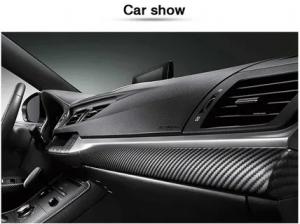Automotive Plastic Interior Trims Market to Reach USD 63.77 Billion by 2035 Amid Shift Lightweight & Vehicle Designs
Automotive plastic interior trims market grows on lightweight, durable, and aesthetic solutions for vehicle interiors, driven by rising auto production.
As automakers increasingly prioritize fuel efficiency and emissions compliance, plastic interior trims offer a viable solution to reduce vehicle mass without compromising structural integrity. These materials are also easier to mold into complex shapes, allowing manufacturers to create more sophisticated and ergonomic cabin designs. Moreover, advancements in surface finishing techniques, such as laser texturing and soft-touch coatings, are elevating the sensory and visual appeal of plastic trims. The rapid growth of electric vehicles (EVs) and premium compact cars is contributing to the rising use of sustainable and recycled plastics, as brands seek to align with environmental standards and consumer preferences for eco-conscious mobility. In parallel, the integration of smart technologies into interior surfaces, such as ambient lighting and touch-sensitive controls, is further driving innovation in plastic trim applications.
Get Ahead with Our Report: Request Your Sample Now!
https://www.futuremarketinsights.com/reports/sample/rep-gb-9056
Key Takeaways from the Automotive Plastic Interior Trims Market:
The global market is anticipated to grow from USD 32.1 billion in 2025 to USD 63.8 billion by 2035, driven by a 7.1% CAGR. Lightweight plastic trims play a vital role in meeting fuel economy targets and carbon emission standards, especially as governments tighten environmental regulations. Passenger vehicles represent the largest application segment due to the rising demand for premium interiors across both mass-market and luxury segments. Original equipment manufacturers (OEMs) dominate the market share, although the aftermarket segment is also growing, particularly in regions with older vehicle fleets and increased demand for refurbishment. Asia Pacific leads the global market, underpinned by strong vehicle production in China, India, Japan, and South Korea, while Europe and North America continue to show robust demand for high-performance, customizable interior components.
Emerging Trends in the Global Automotive Plastic Interior Trims Market:
One of the most prominent trends in the market is the increasing use of recycled and bio-based plastics to enhance sustainability while maintaining performance. Automakers are working with suppliers to develop interior trims that meet both environmental benchmarks and aesthetic expectations. Additionally, digital design and simulation tools are being adopted to accelerate prototyping and reduce time-to-market for new trim designs. The growing popularity of minimalist and tech-integrated cabin layouts is encouraging the use of lightweight, modular plastic trims that can house infotainment systems, integrated touch panels, and dynamic lighting features.
There is also a marked trend toward customizable interiors, with plastic trims playing a central role in delivering unique textures, colors, and finishes to match consumer lifestyle preferences. The rise of electric and autonomous vehicles is further influencing interior trim design, with greater focus on user-centric cabin spaces that emphasize comfort, personalization, and intuitive control layouts. Enhanced material innovations, such as scratch-resistant and anti-microbial surfaces, are being incorporated to improve durability and hygiene in high-touch areas.
Significant Developments in the Global Sector: Trends and Opportunities in the Market:
Several key developments are reshaping the market landscape. OEMs are increasingly partnering with Tier 1 and Tier 2 suppliers to co-develop next-generation trim components that support modular vehicle platforms and smart cabin technologies. These partnerships are enabling faster integration of innovations such as backlit panels, translucent materials, and advanced acoustic solutions, which enhance both functionality and cabin ambiance. The rising use of Industry 4.0 technologies—including automation, robotics, and additive manufacturing—is allowing for more precise and cost-effective production of intricate trim parts.
Opportunities abound in developing markets, where increasing vehicle ownership, urbanization, and disposable income are spurring demand for enhanced in-cabin experiences. Additionally, the premium segment is witnessing strong interest in luxury-grade plastic trims with metallic finishes and leather-like textures, providing high-end appeal without the associated weight or cost. Regulatory support for vehicle recyclability and sustainability is also prompting manufacturers to invest in closed-loop systems and green material sourcing.
Recent Developments in the Market:
The last few years have witnessed several notable product launches and expansions in the plastic interior trims space. Major suppliers have introduced new material blends that combine strength, flexibility, and reduced environmental impact. For instance, the use of fiber-reinforced polymers and hybrid composites is gaining traction for applications that demand high performance under dynamic loads. Global players have also expanded production capacities in emerging markets to meet growing regional demand and reduce logistics costs.
Automakers are actively experimenting with multi-material trims that incorporate electronic features such as touch sensors, haptic feedback, and integrated displays. The use of soft foams and 3D-printed textures is being explored to enhance tactile quality and passenger engagement. In line with the smart mobility trend, several OEMs have announced interior concepts that eliminate traditional switches in favor of seamless, sensor-embedded plastic panels.
Detailed Market Study: Full Report and Analysis
https://www.futuremarketinsights.com/reports/automotive-plastic-interior-trims-market
Competition Outlook:
The automotive plastic interior trims market is moderately fragmented, with a mix of global giants and specialized regional players competing on quality, customization, cost, and sustainability. Leading companies are focusing on product differentiation through innovative surface treatments, sustainable materials, and integration with smart technologies. Strategic alliances, acquisitions, and investments in localized manufacturing are common approaches to strengthen market position and enhance responsiveness to OEM requirements.
Key Players
Key players in the global automotive plastic interior trims market include Faurecia, Grupo Antolin, Lear Corporation, International Automotive Components (IAC) Group, Toyota Boshoku Corporation, Magna International Inc., Visteon Corporation, Yanfeng Automotive Interiors, Trinseo S.A., and DURA Automotive Systems. These companies are driving market innovation through design expertise, global supply networks, and R&D in lightweight and recyclable plastics.
Key segmentations
The market is segmented by material type (polypropylene, ABS, polycarbonate, PVC, others), by application (dashboard, door panels, center consoles, pillars, others), by vehicle type (passenger vehicles, light commercial vehicles, heavy commercial vehicles), and by sales channel (OEM and aftermarket). Among these, dashboards and door panels are expected to remain the largest application areas due to high surface area utilization and frequent consumer interaction. OEMs will continue to lead in volume and revenue, while aftermarket demand will remain strong in markets with older vehicle populations and personalization trends.
Automotive Interior Industry Analysis Reports
Automotive Interior Ambient Lighting System Market Forecast and Outlook from 2025 to 2035
https://www.futuremarketinsights.com/reports/automotive-interior-ambient-lighting-systems-market
Automotive Load Floor Market Forecast and Outlook from 2025 to 2035
https://www.futuremarketinsights.com/reports/automotive-load-floors-market
Bus Flooring Market Forecast and Outlook from 2025 to 2035
https://www.futuremarketinsights.com/reports/bus-flooring-market
Automotive HVAC Blower Market Size and Share Forecast Outlook (2025 to 2035)
https://www.futuremarketinsights.com/reports/automotive-hvac-blower-market
Automotive Soft Trim Interior Materials Market Forecast and Outlook from 2025 to 2035
https://www.futuremarketinsights.com/reports/automotive-soft-trim-interior-materials-market
Ankush Nikam
Future Market Insights, Inc.
+ +91 90966 84197
email us here
Visit us on social media:
LinkedIn
Facebook
YouTube
X
Legal Disclaimer:
EIN Presswire provides this news content "as is" without warranty of any kind. We do not accept any responsibility or liability for the accuracy, content, images, videos, licenses, completeness, legality, or reliability of the information contained in this article. If you have any complaints or copyright issues related to this article, kindly contact the author above.
Accounts Receivable Outsourcing Services Support Financial Clarity Across U.S. Healthcare
American Receivable Celebrates 46 Years of Success and Steady Leadership
Global Ready-Mix Concrete Market Is Expected to Reach $704.2 Billion by 2030: Says AMR
Więcej ważnych informacji
 Jedynka Newserii
Jedynka Newserii

 Jedynka Newserii
Jedynka Newserii

Polityka

D. Joński: Nie wiemy, co zrobi Rosja za dwa–trzy lata. Według duńskiego wywiadu może zaatakować kraje nadbałtyckie i musimy być na to gotowi
Zdecydowana większość krajów unijnych wskazuje na potrzebę wzmocnienia zdolności obronnych Europy w obliczu coraz bardziej złożonego geopolitycznego tła. Wywiady zachodnich państw wskazują, że Rosja może rozpocząć konfrontację z NATO jeszcze przed 2030 rokiem. Biała księga w sprawie obronności europejskiej „Gotowość 2030” zakłada m.in. ochronę granic lądowych, powietrznych i morskich UE, a sztandarowym projektem ma być Tarcza Wschód. – W budzeniu Europy duże zasługi ma polska prezydencja – ocenia europoseł Dariusz Joński.
Transport
Duże magazyny energii przyspieszą rozwój transportu niskoemisyjnego w Europie. Przyszłością może być wodór służący jako paliwo i nośnik energii

Zmiany w europejskim transporcie przyspieszają. Trendem jest elektromobilność, zwłaszcza w ramach logistyki „ostatniej mili”. Jednocześnie jednak udział samochodów w pełni elektrycznych w polskich firmach spadł z 18 do 12 proc., co wpisuje się w szerszy europejski trend spowolnienia elektromobilności. Główne bariery to ograniczona liczba publicznych stacji ładowania, wysoka cena pojazdów i brak dostępu do odpowiedniej infrastruktury. – Potrzebne są odpowiednio duże magazyny taniej energii. Przyszłością przede wszystkim jest wodór – ocenia Andrzej Gemra z Renault Group.
Infrastruktura
W Polsce w obiektach zabytkowych wciąż brakuje nowoczesnych rozwiązań przeciwpożarowych. Potrzebna jest większa elastyczność w stosowaniu przepisów

Pogodzenie interesów konserwatorów, projektantów, inwestorów, rzeczoznawców i służby ochrony pożarowej stanowi jedno z największych wyzwań w zakresie ochrony przeciwpożarowej obiektów konserwatorskich. Pożary zabytków takich jak m.in. katedra Notre-Dame w Paryżu przyczyniają się do wprowadzania nowatorskich rozwiązań technicznych w zakresie ochrony przeciwpożarowej. W Polsce obowiązuje już konieczność instalacji systemów detekcji. Inwestorzy często jednak rezygnują z realizacji projektów dotyczących obiektów zabytkowych z uwagi na zmieniające się i coraz bardziej restrykcyjne przepisy czy też względy ekonomiczne.
Partner serwisu
Szkolenia

Akademia Newserii
Akademia Newserii to projekt, w ramach którego najlepsi polscy dziennikarze biznesowi, giełdowi oraz lifestylowi, a także szkoleniowcy z wieloletnim doświadczeniem dzielą się swoją wiedzą nt. pracy z mediami.




![Nestlé w Polsce podsumowuje wpływ na krajową gospodarkę. Firma wygenerowała 0,6 proc. polskiego PKB [DEPESZA]](https://www.newseria.pl/files/1097841585/fabryka-nesquik_1,w_85,r_png,_small.png)




.gif)

 |
| |
| |
|